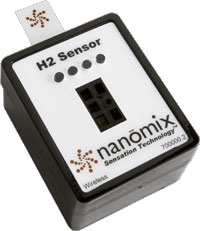Emeryville, CA-based Nanomix has developed a hydrogen detector based on a carbon nanotube device that solves some of the headaches that plague users of traditional detectors.
Most current detection devices rely on catalytic bead or metal oxide sensor (MOS) technologies, which have significant performance limitations. While both technologies can detect hydrogen, the catalytic bead technology does not differentiate between hydrogen and other gases, such as propane, isopropanol and carbon monoxide leading to a high rate of false alarms. MOS based devices are also sensitive to temperature and humidity, as well as other hydrocarbons.
But the company says that its Nanomix Sensation nanoelectronic detection technology overcomes such false alarms, while providing other important features including increased safety, simple deployment accuracy, low power consumption, longer calibration intervals, and optional wireless system integration.

The Nanomix detector does so through the use of a detector that marries carbon nanotubes and silicon microstructures. The nanotube network itself is coated with a recognition layer that interacts with the chemical or biological analyte of interest – in this case hydrogen. Interactions between the recognition layer and the analyte result in a measurable change in the electronic characteristics of the detection device.

The initial response to hydrogen, measured through a change in the electrical impedance of the sensor, can occur within a few seconds and hydrogen concentration can be measured in the range of 2,000ppm to 20,000ppm, which is 5% to 50% of the Lower Explosion Limit (LEL) for hydrogen.
Concurrently, Nanomix has appointed KWJ Engineering as its first distributor with volume orders being accepted for the first time.




Swiss geoengineering start-up targets methane removal
No mention whatsoever about the effect of increased methane levels/iron chloride in the ocean on the pH and chemical properties of the ocean - are we...